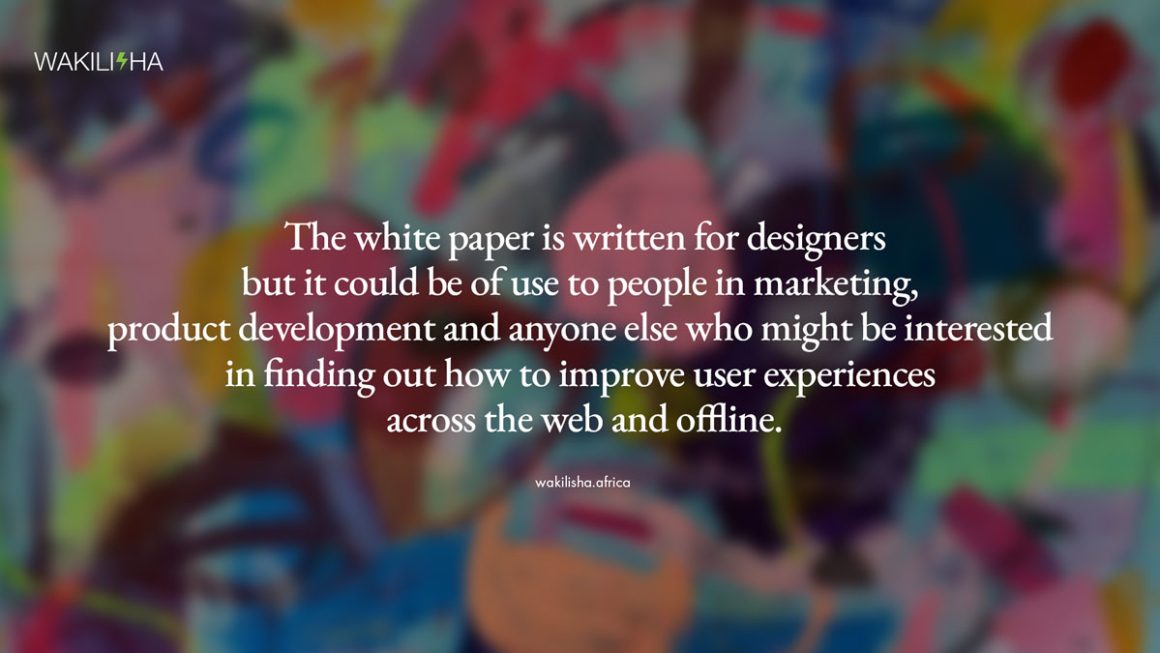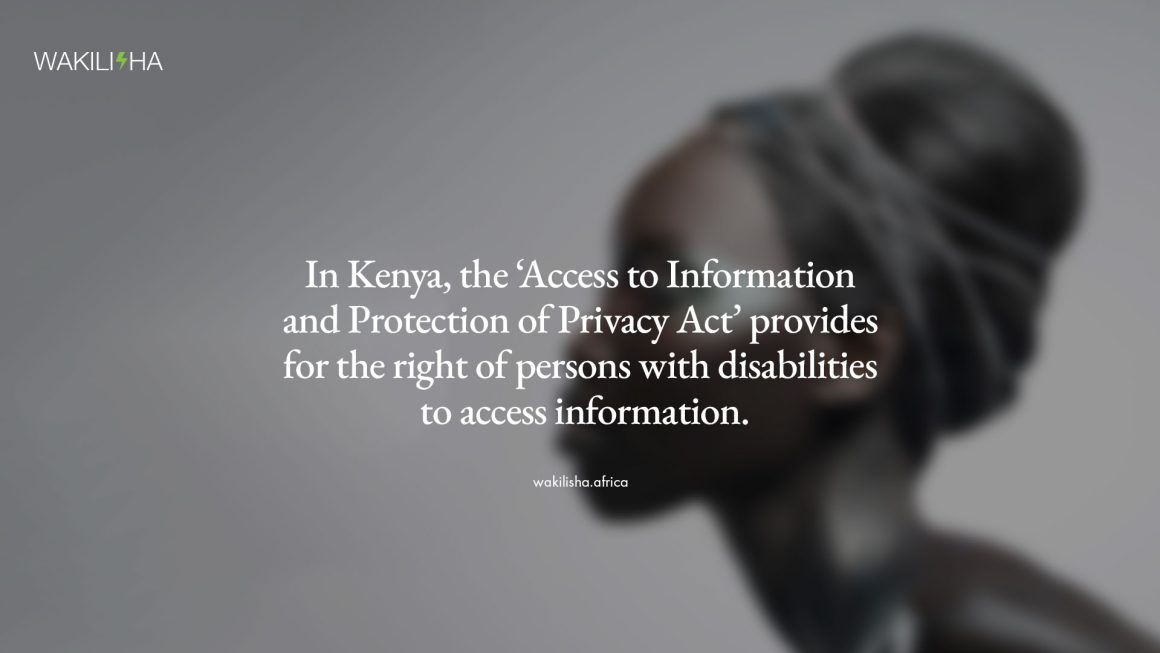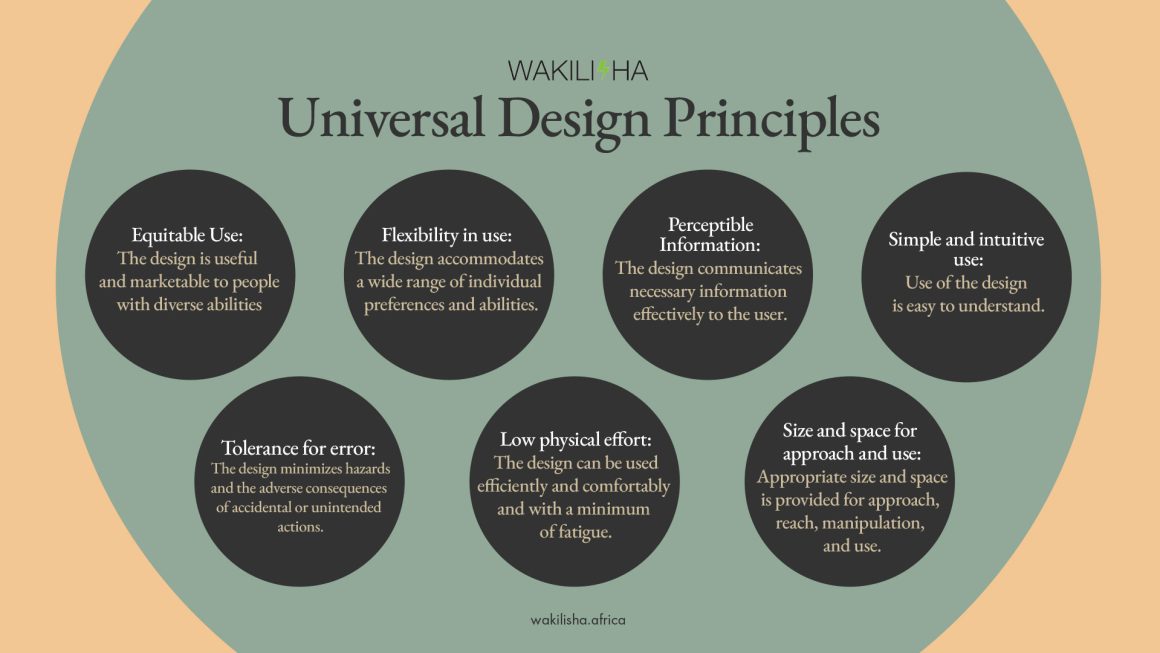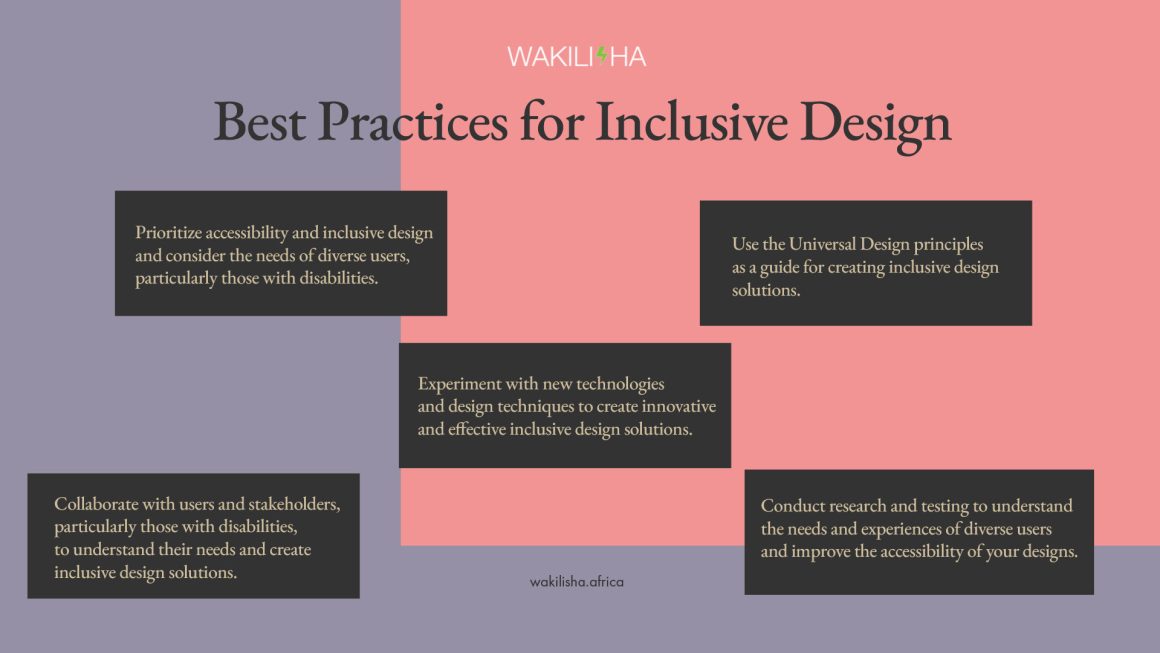CONTENTS
- Overview of the importance of designing for accessibility
- Purpose and scope of the white paper
Understanding Accessibility in Design
- Definition and types of accessibility
- The impact of inaccessible design on disabled people
- Legal and policy frameworks for accessibility in Kenya
Best Practices for Inclusive Design
- Universal design principles and how they apply to different design disciplines (e.g., web design, architecture, product design)
- Examples of inclusive design solutions in Kenya and globally
- Tools and resources for designers to create accessible designs
Challenges and Opportunities in Implementing Inclusive Design
- Common challenges faced by designers and industry players in implementing inclusive design solutions
- Opportunities for collaboration and innovation in the design community to improve accessibility
- Summary of key findings and recommendations for designers and industry players
- Future directions for research and advocacy in inclusive design
- References and further reading
Introduction
Overview of the importance of designing for accessibility
Imagine a world where everyone has the opportunity to participate in the digital and built environments that shape our lives, regardless of their abilities or disabilities. This is the world we want to create, and it starts with designing for accessibility.
Accessibility is not just about compliance with laws and regulations. It’s about creating an inclusive and equitable society where everyone can thrive. And it’s not just the right thing to do, it’s also good business. Inclusive design leads to more innovative and successful products, services, and spaces that meet the needs of a diverse user base.
But despite this, accessibility is still often an afterthought in the design process, and people with disabilities are often left out of the equation. Not just in Kenya, but in every country. This white paper aims to change that.
Purpose and scope of the white paper
The white paper is written for designers but it could be of use to people in marketing, product development and anyone else who might be interested in finding out how to improve user experiences across the web and offline. It will provide an overview of the importance of designing for accessibility and best practices for inclusive design in digital and built environments. It will also explore the challenges and opportunities that surround the implementation of inclusive design in Kenya and beyond.
Our goal is to educate and empower practitioners in the design industry to create accessible and inclusive designs that will benefit everyone. Because when we design for accessibility, we are creating a better world for all.
Understanding Accessibility in Design
Accessibility is not a niche issue. It is a human rights issue, and it is an issue of social justice. It is not just about compliance, it is about creating inclusive and usable products, services, and environments for everyone. It’s about understanding that everyone has unique needs and abilities, and designing to accommodate those differences. Inclusive design is about creating a world where everyone has the same opportunities to experience and engage with the built and digital environments around them.
Definition and types of accessibility
There are many types of accessibility, such as visual, auditory, cognitive, and motor accessibility. For example, visual accessibility includes designing for people with visual impairments, such as providing alternative text for images, or providing high contrast color schemes. Auditory accessibility includes designing for people who are deaf or hard of hearing, such as providing closed captioning or audio descriptions.
The impact of inaccessible design on disabled people
Inaccessible design can have a profound impact on disabled people around the world. For example, people with disabilities in Kenya often face many barriers to accessing education, employment, and healthcare due to a lack of accessible infrastructure and services in most Kenyan towns.
Legal and policy frameworks for accessibility around the world
The good news is that there are legal and policy frameworks in place around the world to promote accessibility in design.
Kenya
For example, In Kenya, the ‘Access to Information and Protection of Privacy Act’ provides for the right of persons with disabilities to access information, and the Disability Act of 2003 provides for the rights of persons with disabilities to access education, employment, and healthcare.
USA
The Rehabilitation Act of 1973 in the USA was a significant step forward in ensuring equal rights for individuals with disabilities. This law marked the first time in US history that discrimination against people with disabilities was legally prohibited. Prior to this, individuals with disabilities often faced barriers in accessing essential public services such as transportation and telephones. The Americans with Disabilities Act (ADA) is a law enacted in 1990 to ensure people with disabilities are not discriminated against.
Building on the progress made by the Rehabilitation Act of 1973, the Americans with Disabilities Act (ADA) was passed in 1990, further expanding the rights and protections for individuals with disabilities in the United States. The ADA prohibits discrimination on the basis of disability in employment, transportation, public accommodations, and other areas of daily life. It also mandates that public buildings, transportation systems and other facilities make reasonable accommodations to ensure that they are accessible to people with disabilities. The ADA has been instrumental in breaking down barriers and increasing accessibility for individuals with disabilities and continues to be an important law in the fight for equality and inclusion in the United States.
European Union
In the EU, the Web Accessibility Directive and the European Accessibility Act (EAA) directives are not laws in and of themselves, but rather, the directives outline what accessibility should look like, leaving it to each EU member state to integrate the directive into national laws. The former focuses on the public sector, while the latter applies to private companies.
Canada
There are multiple accessibility laws in Canada including the Accessible Canada Act, Accessibility for Ontarians with Disabilities Act, Accessibility for Manitobans Act and the Nova Scotia Accessibility Act.
Australia
Australia’s Disability Discrimination Act 1992 applies to both the private and public sectors and explicitly prohibits providers of goods, services, and facilities from discriminating against people on the ground of a disability.
In conclusion:
- Accessibility in design is not just about compliance, it is about creating inclusive and usable products, services, and environments for everyone.
- It’s about understanding that everyone has unique needs and abilities, and designing to accommodate those differences.
- It’s about creating a world where everyone has the same opportunities to experience and engage with the built and digital environments around them.
Best Practices for Inclusive Design
“Design is not about making things look pretty, it’s about making things work for people.” – Don Norman
Inclusive design is about creating products, services, and environments that are usable by the widest range of people, regardless of their abilities, backgrounds, or circumstances. One of the key principles of inclusive design is Universal Design, which is the design of products and environments that are usable by all people, to the greatest extent possible, without the need for adaptation or specialized design.
Universal Design Principles
Universal Design is a set of seven principles that can be applied to different design disciplines, such as web design, architecture, and product design. These principles include:
Equitable use: The design is useful and marketable to people with diverse abilities.
Flexibility in use: The design accommodates a wide range of individual preferences and abilities.
Simple and intuitive use: Use of the design is easy to understand, regardless of the user’s experience, knowledge, language skills, or current concentration level.
Perceptible information: The design communicates necessary information effectively to the user, regardless of ambient conditions or the user’s sensory abilities.
Tolerance for error: The design minimizes hazards and the adverse consequences of accidental or unintended actions.
Low physical effort: The design can be used efficiently and comfortably and with a minimum of fatigue.
Size and space for approach and use: Appropriate size and space is provided for approach, reach, manipulation, and use regardless of user’s body size, posture, or mobility.
Examples of Inclusive Design Globally
Examples of inclusive design practices for digital environments include opting for legible fonts and offering a button for users to increase the font size. This is particularly important for users with visual impairments, who may have difficulty reading small text.
Alternative Text for non-text content
Additionally, providing text alternatives for non-text content, such as images, is another example of inclusive design practice. This is useful for users who are blind or have low vision, as well as for users who have difficulty reading text, such as users with dyslexia.
Closed Captioning
Providing closed captioning or audio descriptions for video content is another example of inclusive design practice. This is useful for users who are deaf or hard of hearing, as well as for users who have difficulty understanding spoken language, such as users with cognitive impairments.
Built Environments
For inclusive design practices in built environments, there are many examples globally that can be emulated. One example is in Kenya, where the Nairobi County Government has implemented universal design policies in the construction of new public buildings. This policy ensures that new public buildings are designed to be accessible and usable by the widest range of people, including those with disabilities by for instance, providing ramps and elevators for wheelchair users, and tactile paving for visually impaired individuals.
In other places around the world, inclusive design practices can be seen in the use of universal design principles in architecture, such as providing a variety of entrance options, creating multi-purpose spaces and providing good lighting and acoustics to accommodate different needs.
The use of assistive technology in buildings, such as automatic door openers, elevators with voice announcements, and accessible toilet facilities are also examples of inclusive design practices that can be emulated. These practices are not only beneficial to individuals with disabilities, but they also benefit older adults, parents with strollers, and anyone who may be temporarily mobility-impaired.
Designers can use a variety of tools and resources to create accessible designs. These include:
- Accessibility guidelines and standards, such as the Web Content Accessibility Guidelines (WCAG) and the International Organization for Standardization (ISO) guidelines.
- Accessibility testing tools, such as the WAVE web accessibility evaluation tool and the Color Oracle color blindness simulator.
- Accessibility design patterns and examples, such as the Inclusive Design Patterns website and the Accessible Icon Project.
In conclusion:
- Inclusive design will help you create products, services, and environments that are usable by the widest range of people.
- Universal Design principles are a set of guidelines that can be applied to different design disciplines to ensure that designs are inclusive and accessible to all. By using these principles, designers can create solutions that are accessible, simple, and flexible for all users, including those with disabilities.
- Additionally, designers can use a variety of tools and resources to create accessible designs, such as accessibility guidelines and standards, testing tools and design patterns and examples.
Challenges and Opportunities in Implementing Inclusive Design
Implementing inclusive design can be challenging, but also presents many opportunities for collaboration and innovation in the design community. Some of the common challenges faced by designers and industry players in implementing inclusive design solutions include:
- Limited understanding of accessibility needs: Many designers and industry players may not have a deep understanding of the needs and experiences of diverse users, particularly those with disabilities.
- Limited resources and budget: Implementing inclusive design solutions can be costly and time-consuming, particularly for small businesses or organizations with limited resources.
- Lack of collaboration and communication: Designers and industry players may not always collaborate effectively with each other, or with users and stakeholders, to understand and address accessibility needs.
- Limited design education and training: Design education and training programs are not always able to provide students with the knowledge and skills needed to create inclusive design solutions.
Despite these challenges, there are many opportunities for collaboration and innovation in the design community to improve accessibility.
- Collaboration and co-design: designers and industry players can collaborate with users and stakeholders, particularly those with disabilities, to understand their needs and create inclusive design solutions.
- Innovation and experimentation: designers and industry players can experiment with new technologies and design techniques to create inclusive design solutions that are innovative and effective.
- Accessibility research and testing: designers and industry players can conduct research and testing to understand the needs and experiences of diverse users and improve the accessibility of their designs.
- Education and training: designers and industry players can provide education and training to improve the knowledge and skills of designers and industry players in creating inclusive design solutions.
Designing for accessibility is not just about checking off a list of guidelines, it’s about understanding the needs and experiences of diverse users, and creating solutions that work for them.
In conclusion:
- Implementing inclusive design presents many challenges, but also many opportunities for collaboration and innovation in the design community.
- By understanding the needs and experiences of diverse users, and by experimenting with new technologies and design techniques, designers and industry players can create inclusive design solutions that are innovative, effective, and accessible to all.
- Additionally, collaboration and co-design, accessibility research and testing, education, and training can help to improve the accessibility of more products both online and offline.
Conclusion
In this white paper, we have explored the importance of accessibility and inclusive design in the built and digital environments. We have discussed the definition and types of accessibility, the impact of inaccessible design on people with disabilities, and some legal and policy frameworks for accessibility in place in Kenya. We have also provided best practices for inclusive design, including the Universal Design principles, examples of inclusive design solutions and tools and resources which designers can use to create accessible designs. Finally, we have highlighted the challenges and opportunities in implementing inclusive design, and the need for collaboration and innovation in the design community to improve accessibility.
In summary, key findings of this white paper include:
- Accessibility and inclusive design is a human rights issue and social justice, it is about creating a world where everyone has the same opportunities to experience and engage with the built and digital environments around them
- Universal Design principles are a set of guidelines that can be applied to different design disciplines to ensure that designs are inclusive and accessible to all.
- Collaboration and co-design, innovation and experimentation, accessibility research and testing, and education and training are key to improve accessibility and inclusive design.
We recommend that designers and industry players:
- Prioritize accessibility and inclusive design in their work and consider the needs of diverse users, particularly those with disabilities
- Use the Universal Design principles as a guide for creating inclusive design solutions
- Collaborate with users and stakeholders, particularly those with disabilities, to understand their needs and create inclusive design solutions
- Experiment with new technologies and design techniques to create innovative and effective inclusive design solutions
- Conduct research and testing to understand the needs and experiences of diverse users and improve the accessibility of their designs.
Future directions for research and advocacy in inclusive design include:
- Further research on the impact of inaccessible design on needs and experiences of diverse users, particularly those with disabilities.
- Exploration of innovative technologies and design techniques that can improve accessibility and inclusive design
- Greater collaboration between designers, industry players, users and stakeholders to understand and address accessibility needs
- Greater education and training for designers and industry players to improve their knowledge and skills in creating inclusive design solutions.
References and further reading:
- “Universal Design: Creating Inclusive Environments” by Ronald L. Mace
- “Designing for Interaction: Creating Smart Applications and Clever Devices” by Dan Saffer
- “How to Design for the Blind” by WAKILISHA
- “Inclusive Design Patterns” by Heydon Pickering
- “Web Content Accessibility Guidelines (WCAG) 2.1” by the World Wide Web Consortium (W3C)
- “Accessible Icon Project” by David Byrne
- “The Accessibility Guidelines for Built Environment” by World Health Organization (WHO)
Accessibility and inclusive design is a crucial aspect of creating a more equitable society and it is the responsibility of designers, industry players, and policy makers to ensure that the built and digital environments are inclusive for all. We hope that this white paper has provided valuable insights and inspiration for designers and industry players to create inclusive design solutions that are innovative, effective, and accessible to all.
Muiruri Beautah
Muiruri Beautah is a Head Writer at WAKILISHA and a Marketing Manager at Peach Cars. He has created award winning work for brands such as Unilever, Diageo, SafeBoda and Safaricom Plc. He lives in Nairobi and in the hearts of children around the world.








